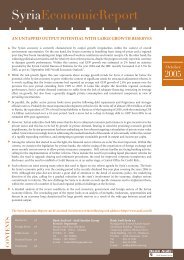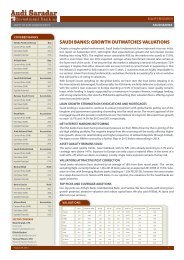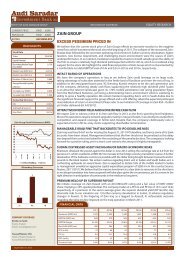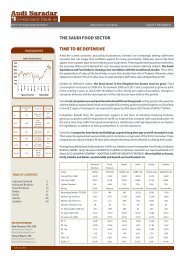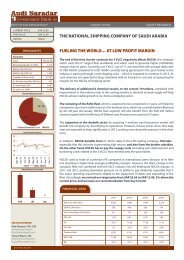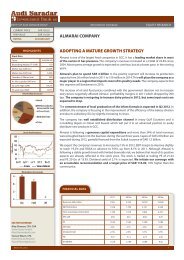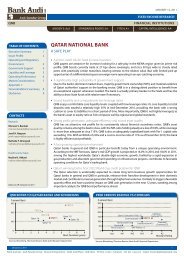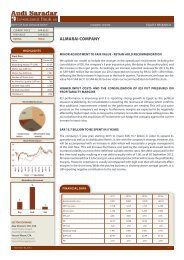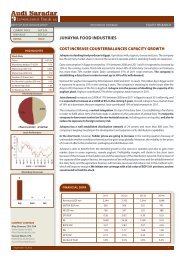sabic - Search Center - Bank Audi
sabic - Search Center - Bank Audi
sabic - Search Center - Bank Audi
Create successful ePaper yourself
Turn your PDF publications into a flip-book with our unique Google optimized e-Paper software.
SABIC INITIATION OF COVERAGE<br />
EQUITY RESEARCH<br />
December 4, 2012<br />
FOOTNOTES<br />
INVESTMENT CASE<br />
CHEMICAL PLAYS: AMONG PRIME BENEFICIARIES OF MONETARY ACOMMODATION<br />
As the global recovery is losing its momentum and signs of sluggish growth are resurfacing, monetary<br />
accommodation is emerging as a crucial policy tool for central banks. Quantitative easing measures<br />
are already underway given: the unlimited bond-purchase program announced by the European<br />
Central <strong>Bank</strong> on September 6, the third round of bond-buying by the US Federal Reserve announced<br />
on September 13th, and the <strong>Bank</strong> of Japan following suit by expanding its asset-purchase fund by<br />
$264 billion. Positive stimulus signals have also extended from China with an infrastructure package<br />
of $158 billion approved in early September. As such, with the loosening of monetary policy by<br />
the Fed, ECB and the BoJ to support growth, chances of a stronger recovery in developed markets<br />
and sustained growth in developing markets have increased. Moreover, a likely compromise on the<br />
“fiscal cliff” would help navigate the newly rising uncertainty and would pave the way for achieving<br />
the projected economic growth figures set by the IMF (in the October 2012 World Economic<br />
Outlook). Accordingly, as chemical demand is largely dependent on economic growth and as<br />
earnings of chemical companies closely track the global manufacturing and industrial activities,<br />
chemical producers will be among the first and the largest to build on any gained momentum in the<br />
global economic recovery. Accordingly, the improvement in real demand for chemicals, combined<br />
with the well-paced capacity expansions, should elevate the global chemical utilization rate from its<br />
33-month low of 84.8%.<br />
Table 1: Projected Growth Rates of Key Economies<br />
Real GDP % 2011 2012E 2013E<br />
World 3.8% 3.3% 3.6%<br />
Advanced Economies 1.6% 1.3% 1.5%<br />
US 1.7% 2.2% 2.1%<br />
Euro Area 1.4% -0.4% 0.2%<br />
Emerging Economies 6.2% 5.3% 5.6%<br />
China 9.2% 7.8% 8.2%<br />
India 7.1% 4.9% 6.0%<br />
Source: IMF World Economic Outlook, October 2012<br />
KEY CHEMICAL MARKETS EXPECTED TO TIGHTEN<br />
Despite a bearish demand environment for crude oil, prices are not expected to subdue in the<br />
medium-term with projections signaling a c$110/bbl floor for Brent. The support for crude oil prices<br />
should stem from: 1/geo-political risks in the region 2/ stimulus effect of QE3 by the US Fed and<br />
3/ further stimulus measures by other key central banks. Not to mention that the first two factors<br />
are expected to linger for an undefined period of time, as geo-political tensions are escalating and<br />
the quantitative easing of the US Federal Reserve is widely expected to be the open-ended type of<br />
bond-buying.<br />
On another front, the oversupplied global chemical markets are expected to tighten over next 4-5<br />
years on the back of stronger chemical demand, as a recovery in developed markets and strong<br />
growth in emerging markets lead to additional demand. Global demand for ethylene, the most<br />
common basic chemical in the industry, is projected to grow at a CAGR of 4.53% for the period 2011<br />
till 2016. Global capacity for ethylene, on the other hand, is projected to grow at a CAGR of 3.05%<br />
for the same period given limited capacity additions across the globe. The excess oversupply of<br />
ethylene is expected to fall from an estimated 23 million tons in 2011 to an estimated 16 million tons<br />
in 2016. Accordingly, the share of the ethylene surplus of global supply will contract from 15.5% to<br />
9.3% for the same period 1 .<br />
1 Source: Braskem Investor Relations presentation, citing IHS<br />
2



